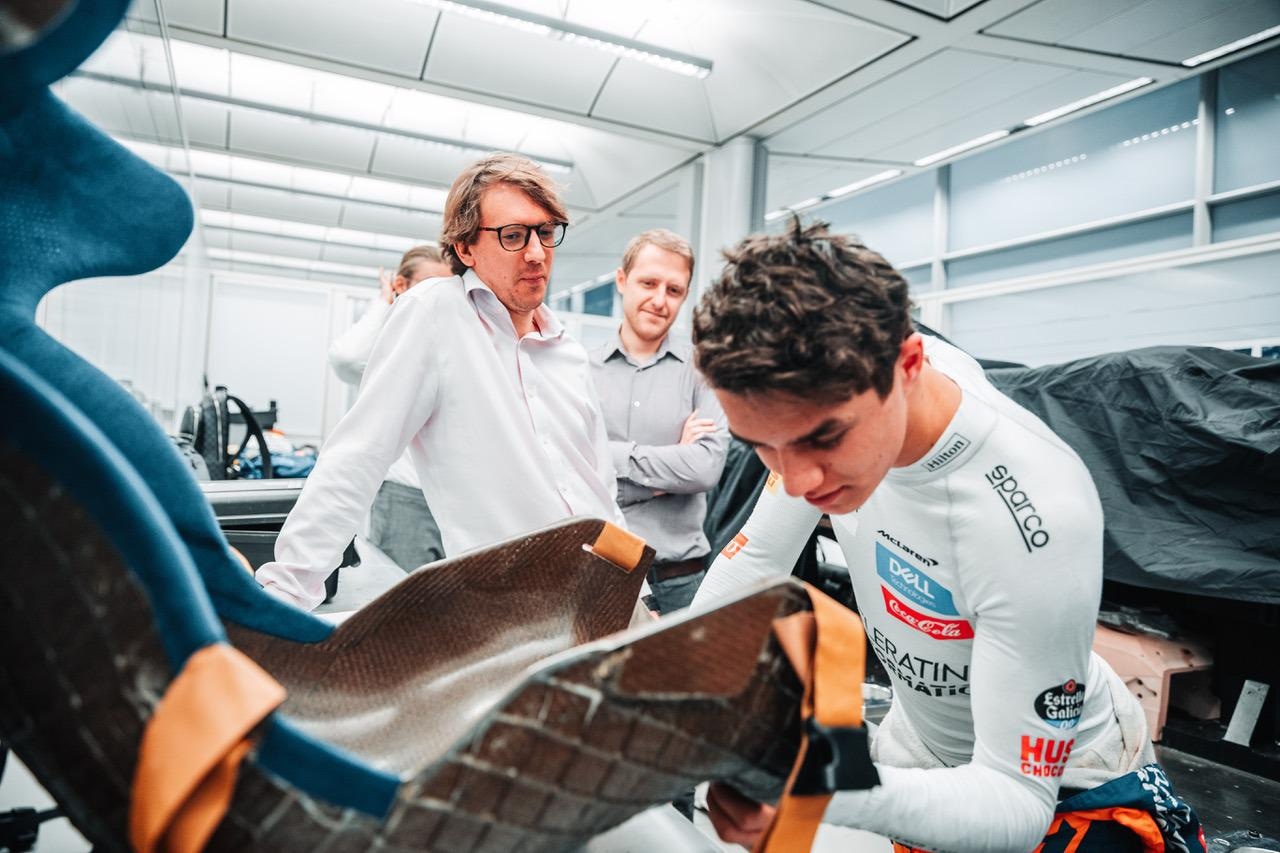CEO of Bcomp, Christian Fischer, talks to AZoM about an important involvement with Formula One's McLaren. The company has helped develop a natural fiber composite racing seat, echoing the racing and automotive industry's move towards more sustainable technologies.
Can you tell us a little bit about what Bcomp does?
It all started as the classic garage story: material science PhD’s that wanted to build skis with extremely high performance to weight ratio. That soon turned into Bcomp, a Swiss cleantech scaleup that develops sustainable lightweighting solutions from natural fibers. We have always been aware that we need to have a high-performance product – while adding a sustainability benefit. Now our products are used in sports, space, Formula 1, luxury yachts, and soon in your everyday car. We always work closely together with our customers to develop solutions.
Bcomp and McLaren have collaborated to produce Formula One’s first natural fiber composite racing seat. What drove this development?
Motorsports, in large, are putting sustainability higher on the agenda: it has always been a technology development platform for automotive. To remain relevant today and attract a new generation of audiences and sponsors, developing and testing new and sustainable technologies is essential for the sport and its contribution to mobility.
McLaren was a leader in introducing carbon fibers to motorsport. Today, it is the leading F1 team in terms of working with sustainable technologies. This makes McLaren the perfect collaborator for this venture, and we are humbled and proud to have this technical development with them.

Image Credit: McLaren
How does the natural fiber racing seat compare to the standard carbon fiber racing seat?
The composite shell of the seat is made entirely from natural fibers. While matching the performance requirements, it means up to 75% lower CO2 emissions. The parts can be incinerated for energy recovery without residual waste at end of life instead of going to landfills. Material costs are reduced, the risk of sharp shattering mitigated, and vibration damping – important to the driver’s comfort – is up to 250% higher. Thanks to powerRibs™ technology, it is the first time that natural fiber composites can replace carbon fibers.
What is Bcomp’s powerRibs technology, and how is it used in the seats?
The powerRibs™ technology is inspired by the veins on the back of a leaf. Creating a 3D structure on one side of a thin shell maximizes stiffness at minimal weight to enable less base material and reduce weight, cost, and consumables in production. The proprietary technology is perfect for high-performance applications such as replacing or reinforcing carbon fibers in motorsport bodywork or decreasing weight in automotive interior panels with natural fibers.
For the McLaren F1 seats, the powerRibs™ are used on the outside/back of the seat – it is the grid pattern visible in pictures. They are essential to reach the necessary stiffness to weight; otherwise, the seat would be too heavy at the required properties.
What do sustainable composites mean for the automotive industry, and how will it change the driving experience?
One of our engineers said, “We hope to be in the lives of many, without them noticing”, referring to having more sustainable products without compromising the performance or experience. It should not have to be an active choice for the consumer, but the natural way to go.
However, as our technologies for automotive interior panels enable significant weight reductions by using smaller volumes of material more efficiently, there is a positive impact on driving range/fuel consumption and improved vibration damping. A lower volume of material is also related to lower VOC, and not least, improved crash behavior as the powerRibs™ prevent shattering.
How is safety impacted when using Bcomp’s natural fiber composites to construct a racing seat?
We performed reversed engineering of the carbon fiber seat and developed a natural fiber seat that does not compromise the required properties. Therefore, it is also essential to know what applications to use natural fibers. Our sweet spot is thin-walled non- or semi-structural applications that are mainly loaded in stiffness/designed for stiffness. There are applications where the strength to weight is more critical, and then carbon fibers can be more appropriate. It is important to have a close and honest dialogue with customers.
What process is involved to ensure the seat has the required strength to withstand F1 racing conditions?
In addition to the reverse engineering and modeling approach described in the previous question, the seat has been tested on the track by Lando Norris during the February pre-season tests in Barcelona, confirming that the seat behaves according to our calculations and everybody’s expectations. It is continuously tested during on-track testing and will eventually undergo the final homologation by the FIA.
How does the natural-fiber composite seat represent a step forward in the automotive and racing industry?
Being present in F1, the pinnacle of motorsports, is pivotal for sustainable technologies. McLaren takes the position of using F1 as an innovation platform for cleaner technologies – and F1, in general, is also moving in this direction, to remain the leading innovation platform and remain relevant to the automotive industry, sponsors, and audience. Road relevance is crucial and allows for technology transfer from race to road, which is one significant purpose of racing – an innovation platform for tomorrow's technologies.
Do you have any other projects that you are currently working on?
Yes, our sustainable lightweight technologies are currently used in 16 racing series worldwide – from F1 and GT to rally. Porsche Motorsport recently launched a full natural fiber body kit for Four Motors’ Cayman GT4 MR.
Outside of motorsports, we are collaborating with the European Space Agency and have made a satellite panel. We are working with many leading brands in sports and leisure, and have recently entered the marine sector, where Baltic Yachts are currently building two fantastic sailing yachts.
We are also working with multiple automotive brands for interior panels. The cycles are long, but the developments are positive. Last spring, Geely and Volvo Cars-owned electric performance brand Polestar launched the Polestar Precept, which has all interior panels using our materials. That was also a significant milestone and a great collaboration.
Where can readers find more information?
www.bcomp.ch
McLaren
https://www.bcomp.ch/news/mclaren-racing-pioneering-sustainable-lightweighting-in-f1/
https://www.mclaren.com/racing/team/natural-fibre-sustainable-composite-racing-seat/
Polestar
https://www.polestar.com/
https://www.youtube.com/watch?v=dfivqeZHTlA
Porsche Motorsport
https://www.bcomp.ch/news/porsche-full-natural-fibre-bodykit/
Baltic Yachts
https://www.balticyachts.fi/yachts/baltic-68-cafe-racer/
About Christian Fischer
 Christian Fischer is the CEO of Bcomp Ltd, a PhD engineer in material sciences, and a mountain lover. He left corporate and co-founded Bcomp to challenge traditional lightweight material technologies. Today, Bcomp is an award-winning, leading supplier of sustainable lightweight solutions and part of the ongoing revolution towards cleaner mobility.
Christian Fischer is the CEO of Bcomp Ltd, a PhD engineer in material sciences, and a mountain lover. He left corporate and co-founded Bcomp to challenge traditional lightweight material technologies. Today, Bcomp is an award-winning, leading supplier of sustainable lightweight solutions and part of the ongoing revolution towards cleaner mobility.
The Swiss high-tech company has created and entered new markets and is well on the way to establish itself in the large-scale automotive industry. Fluent in several languages, Christian also teaches Entrepreneurship, Innovation and Composite Materials at universities.
Disclaimer: The views expressed here are those of the interviewee and do not necessarily represent the views of AZoM.com Limited (T/A) AZoNetwork, the owner and operator of this website. This disclaimer forms part of the Terms and Conditions of use of this website.